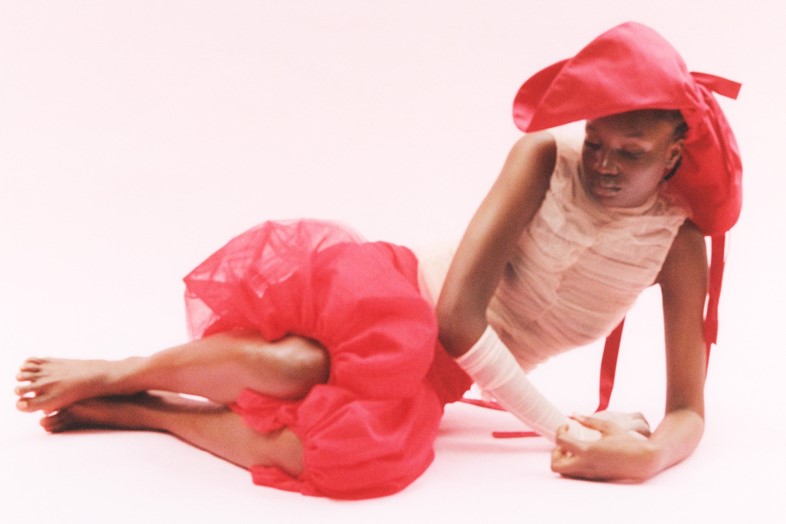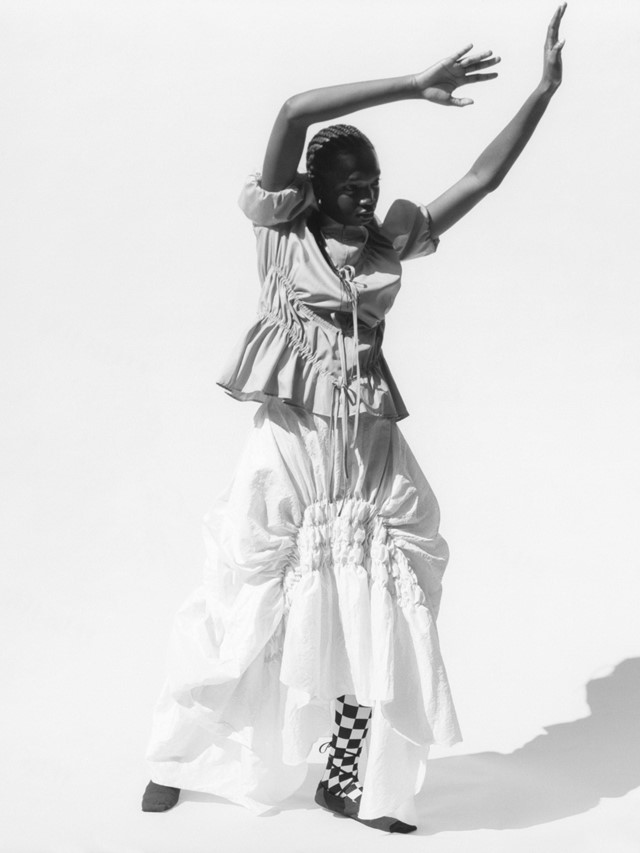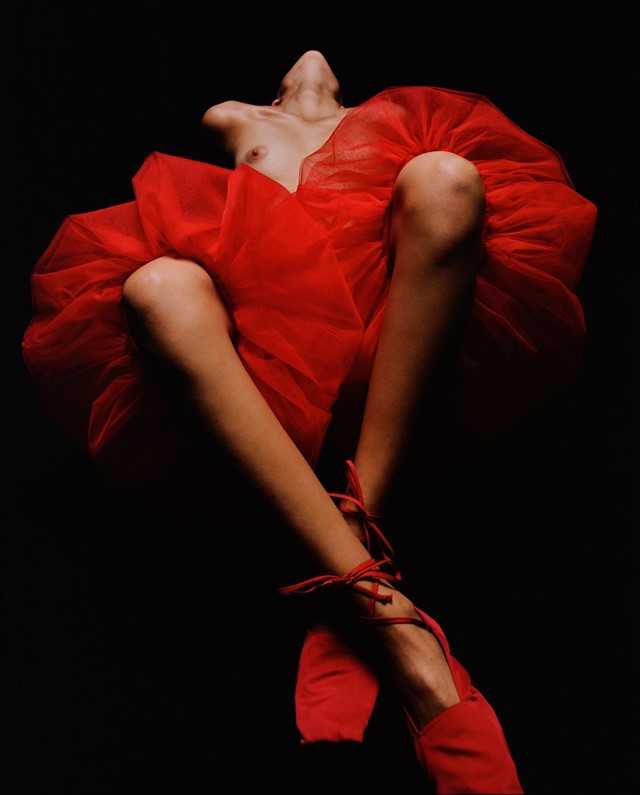Central Saint Martins graduate Cynthia Merhej makes timeless, immaculately-constructed clothing as an answer to sustainability
- Who is it? Beirut-born, Paris-based designer Cynthia Merhej is part of the third generation of women in her family to start her own atelier
- Why do I want it? Timelessly elegant and immaculately-constructed pieces made with sustainability in mind
- Where can I get it? The label’s Pre-Spring 2021 collection is available for purchase exclusively at Net-A-Porter
Who is it? “Designing clothes is basically all I knew, growing up,” Renaissance Renaissance founder Cynthia Merhej tells me over Zoom from her new Paris-based studio. The designer is part of the third generation of women in her family to start her own atelier, following her great-grandmother and her mother. Merhej recalls being raised in this atelier environment in her native Beirut: “It wasn’t all the glamorous kind of fashion,” she says. “It was really gritty, the behind-the-scenes of how clothes are made. That was my education in fashion.”
After a childhood spent in the atelier with her mother, Merhej decided to distance herself from the vocation. “I wanted to take a step back,” she continues, “I was interested in a lot of other things and wanted to explore it all.” At age 17, she moved to London where she studied for six years – first Visual Communication at Central Saint Martins, then the Royal College of Art. While doing this, she discovered a newfound passion for the worlds of creative direction and branding, which complemented her deep-rooted love of fashion and clothing. “I got to a point where I realised I could curate my own umbrella under which I could put all my interests – art direction, branding, fashion – together. And that’s how the brand was born.”
Merhej moved back to Beirut to found Renaissance Renaissance in 2016. For the first year or two, she was working out of her mother’s atelier, learning how to sew, how to cut patterns from scratch. “I taught myself all of that stuff. And, obviously, my mother was helping me a lot. To catch up to her level – 30 years in couture – within a year or two, I really pushed myself so I could communicate with her.” Merhej’s re-education proved fruitful on both of their behalves. “My mother challenged herself a lot, as well, to understand what I wanted because I was asking her to make things she’d never made in her life before. I went into pattern-making like, ‘This is fun. Cool, I can do this? I’m going to use it to fuck things up.’ Sometimes you need someone to come in with a bit of an outsider perspective asking, ‘Why? Why should we do it this way?’ ...I really do believe that if you want to create something that hasn’t been seen before, you have to understand where it came from and how it’s made in order to push it further.”
Up until Renaissance Renaissance was picked up by Net-a-Porter for a Pre-Spring 2021 capsule, Merhej, her mother and a seamstress were handcrafting each of the label’s pieces themselves, out of that same atelier. Now, with a slightly larger production run, Merhej is working with her cousin who owns a factory in Beirut; but it’s still a family affair.
Merhej describes Renaissance Renaissance as not a fashion brand or label, but a platform for creatives from all disciplines. Frequent Renaissance Renaissance collaborators – part of what Merhej calls the label’s family – are photographer Alice Neale, stylist Makram Bitar, and model Carla Daher. “What I’m finding amazing about the brand is that these people are becoming attracted naturally and we’re finding each other naturally. It’s not fast; it’s a very slow process, but we’re building something collectively.”

Why do I want it? Renaissance Renaissance is very much an ode to Merhej’s heritage: her upbringing in her mother’s atelier, in “a female-led couture environment,” as she puts it. “My mother was also doing a lot of couture, having clients who would order their wardrobe for the season. Clients would keep pieces from her from age 30 to age 60, and they would come back with the same piece 30 years later asking for my mother to remake it in a bigger size,” Merhej explains. “I think that’s a beautiful thing. It’s something you carry with you through all those different stages of your life. And that’s how I approach making clothes. For me, it’s very much about looking into the construction, into the fabric. It’s not about making a fad or something that’s just going to be worn for one season.”
In this way, Renaissance Renaissance is about constant evolution. (“That’s where the name comes from, literally,” Merhej says.) With the label, Merhej seeks to create timeless pieces (of course, from the label’s singular perspective) through a slow process of trial and error, experimentation, editing, and rethinking. “I’m constantly working and re-working, going deeper and deeper into how clothes are made, into how we’re making them. I’m interested in looking at bigger, existential questions like who we are, what do we mean in this world, and how do we communicate ourselves through what we wear. It’s a lifetime process,” she says, with a laugh.
Although Merhej is perpetually refining the label’s visual language, she feels like she landed on something special for Renaissance Renaissance’s newly-launched Net-a-Porter capsule. Seeing all the pieces next to each other, like a dress she’d designed two years ago and a jacket she’d conceived only six months prior, Merhej says she “understand[s] how it’s all starting to come together. The language is slowly starting to form because the pieces are naturally falling next to each other and working even though they were made in different periods.” This is the goal, a wardrobe that transcends time, that a woman can wear for 20, 30, 40 years to come.

This sort of perennial wardrobe – and this constant tinkering with construction – is also how Merhej approaches the question of sustainability. “To me, the true answer to sustainability is to keep production runs low, making clothes to last, and, of course, trying to work with natural fibres that are biodegradable.” Trying to action these issues, however, has proved challenging to the designer, as the owner of a young label. “When you’re a small brand you realise you’re up against a much bigger system. We’re talking about production systems, buyers,” she explains. Taking matters into her own hands, for the label’s upcoming capsule, Merhej decided to reduce potential waste by disposing of zippers and buttons in her design. “That’s where knowing construction and how to make clothes came in handy. I was revisiting old pieces and figuring out how to design them without these fastenings,” she explains. “It’s also a more inclusive way to design. When you don’t have a zipper, you’re not restricting a garment to be worn one single way, to one single size. Now that I’ve started designing this way, I can’t go back.” This is only a small step towards the designer’s end-goal, “to create clothes that you can throw into your garden and they’ll biodegrade.”
Finally, one of the collection’s stand-out pieces – the “Juliet” dress, a pink floor-length frock with balloon hem – illuminates another facet of the label’s ethos. The gown’s distinctive puff shape was inspired by the sirwal, a staple of Middle Eastern dress. “What I found beautiful about this piece was that it was worn by men and women. For women, it served the purpose to be modest, but at the same time it allowed them to move because it was a pant. For me that’s what the brand is about,” she says. “I want the woman who wears Renaissance to feel powerful. That’s the main thing for me: power and freedom.”
Where can I get it? The label’s Pre-Spring 2021 collection is available for purchase exclusively at Net-A-Porter.






